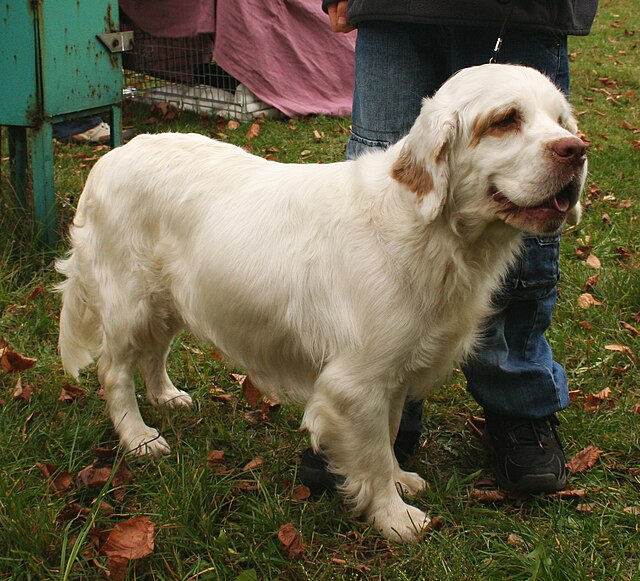


The Clumber Spaniel is a large, sturdy dog that is known for its distinctive appearance and calm, affectionate nature. Originally bred for flushing game in the field, the Clumber Spaniel is an excellent companion for those looking for a laid-back yet active dog. It is often considered a rare breed, but it has a strong following among dog lovers, particularly those who appreciate its calm temperament and excellent nose. The Clumber Spaniel is friendly, good-natured, and loves being around its family, making it a wonderful pet for households with space to accommodate its size and needs.
The Clumber Spaniel is one of the oldest spaniel breeds, with origins in the United Kingdom. It is believed to have been developed in the 18th century, likely by crossing the now-extinct St. Hubert Hound with various other spaniels, including the Basset Hound. The breed was initially developed for hunting purposes, specifically for flushing game birds from dense cover. Its name is derived from Clumber Park in Nottinghamshire, where the breed was first refined and popularized. The Clumber Spaniel was highly valued by British royalty, particularly by the Duke of Newcastle, who played a significant role in the breed’s development. Today, the Clumber Spaniel is primarily kept as a companion dog but still retains its hunting instincts and keen sense of smell.
The Clumber Spaniel is a medium to large-sized dog with a distinctively stocky build. Adult males typically stand between 17 to 20 inches at the shoulder, with females being slightly smaller. Their weight ranges from 55 to 85 pounds, with males being heavier than females. The breed has a dense, waterproof coat that is typically white with lemon, orange, or sable markings. The coat is long, thick, and slightly wavy, requiring regular grooming to prevent matting. The Clumber Spaniel's face is one of its most recognizable features, with a broad, square head, heavy eyebrows, and deep-set, soulful eyes. The breed's ears are long, low-set, and covered with long hair, contributing to its dignified and affectionate expression. The tail is typically carried at a low level, often wagging gently, reflecting the breed’s calm and friendly nature.
The Clumber Spaniel is known for its gentle, laid-back, and friendly temperament. It is a dog that thrives on companionship and enjoys being with its family. While it was originally bred for hunting, the Clumber Spaniel is more relaxed and easygoing in the home environment. This breed is good with children, other dogs, and pets, making it an excellent choice for families. Although they are relatively calm indoors, Clumber Spaniels do have a strong hunting instinct, and they enjoy outdoor activities and games that stimulate their senses. They are generally good-natured and non-aggressive, but they can be reserved or independent with strangers. Early socialization is important to ensure they are well-adjusted in different environments and with various people.
The Clumber Spaniel is a moderately active breed that requires regular exercise to stay healthy and content. While it may not have the high energy levels of some other spaniels, the Clumber Spaniel enjoys daily walks, playtime, and some off-leash exercise in a secure area. It is important to provide this breed with enough mental stimulation, as well as physical activity, to prevent boredom. Due to their hunting instincts, Clumber Spaniels can enjoy activities such as scent work, hunting games, and searching for hidden treats. Although the breed is not as high-energy as some other sporting breeds, regular exercise is still essential to maintain a healthy weight and avoid behavioral issues. Since they are a bit more laid-back than other working dogs, Clumber Spaniels are often well-suited for families with yards or homes where they can relax indoors after their exercise.
The Clumber Spaniel is an intelligent breed, but it can be somewhat independent and stubborn at times. Training should be consistent, gentle, and positive. They respond well to praise and rewards, so positive reinforcement is the most effective training method. Due to their independent nature, it is important to establish clear boundaries and commands early on. Clumber Spaniels generally enjoy being trained, but they may not have the same eagerness to please as some other breeds. Socialization from an early age is important to ensure that they are comfortable with various people, pets, and situations. This breed can be reserved with strangers, but early socialization will help them develop into well-rounded and friendly dogs. They are generally good with other pets, especially if raised together, but may have a tendency to chase smaller animals due to their hunting instincts.
The Clumber Spaniel is generally a healthy breed, but like all dogs, it can be prone to certain health conditions. Common health issues in the breed include hip dysplasia, elbow dysplasia, and hypothyroidism. Regular veterinary check-ups are essential to monitor for these conditions and to maintain overall health. Their long, thick coat requires regular grooming to prevent matting and tangling. Brushing at least twice a week is recommended to keep the coat healthy and clean. Due to the breed's droopy ears, it is also important to check the ears regularly for any signs of infection or wax buildup. Clumber Spaniels are also prone to obesity, so portion control and regular exercise are important to prevent weight gain. Like all dogs, regular dental care and nail trimming are necessary for their health.
The average lifespan of a Clumber Spaniel is between 10 to 12 years. With proper care, including regular exercise, a healthy diet, and veterinary check-ups, many Clumber Spaniels live a long, fulfilling life. Regular monitoring for potential health issues, such as hip dysplasia or ear infections, is important to ensure they remain in good health throughout their lives. Like other larger dogs, they may experience joint issues as they age, so it is important to manage their weight and provide joint supplements if necessary.
© copyright Dog Compendium 2024 - 2025